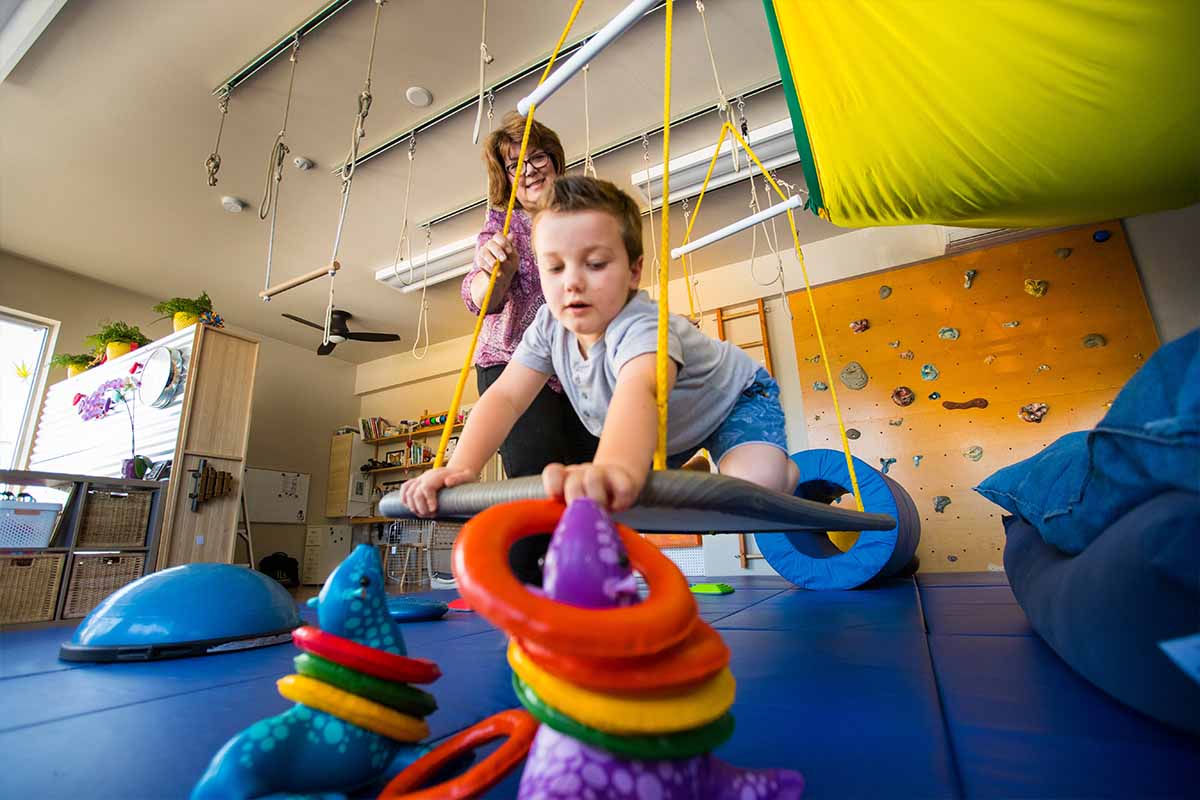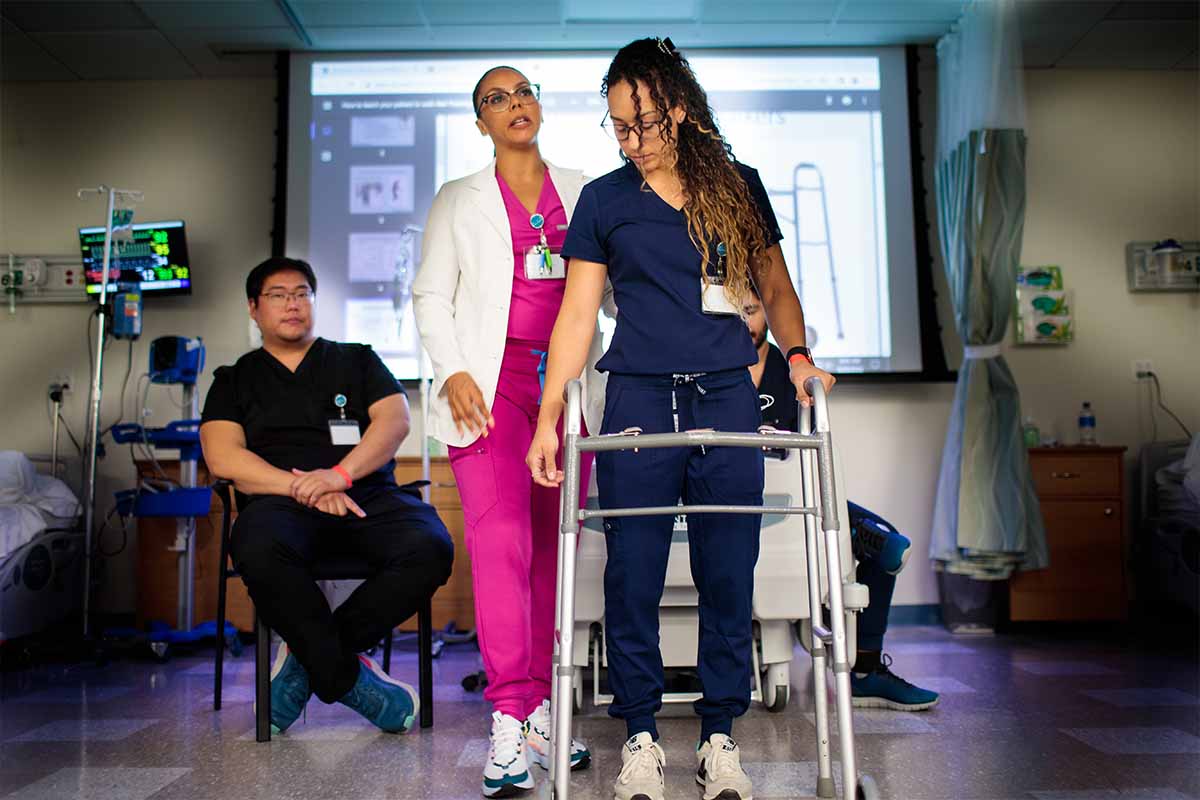
“Telehealth expands the scope of whom therapists can access—and who can access therapy,” says Keith McWilliams, OTD, OTR/L, CBIS, DRS, assistant professor of occupational therapy. When so much of patient care went to telehealth during the early days of the COVID-19 pandemic, our students’ clinical fieldwork went virtual as well. In a series that Dr. McWilliams developed, occupational therapy students on our Dallas campus practice telehealth with adults during their Level I fieldwork. His colleague Hope McCarroll, OTD, OTR, BCP, also an assistant professor of OT in Dallas, developed a similar pediatrics fieldwork experience.


Left: Keith McWilliams, OTD, OTR/L, CBIS, DRS Right: Hope McCarroll, OTD, OTR, BCP
Telehealth with Kids
“The experience was extremely valuable,” says Tyler Chappell, a student in the Doctor of Occupational Therapy (OTD) program. “It was very hands-on. In the telehealth context, I had to think a little harder as a therapist, come up with more tools, be more creative.”
In the Clinical Applications of Occupational Therapy in Pediatrics/Adolescence class, which integrates Level I fieldwork experiences, Chappell and a classmate evaluated and treated a six-year-old boy. Jason (not his real name) has issues with low muscle tone, sensory differences, and hyperactivity. The students worked with Jason to increase his core strength and endurance. They prepared yoga poses, drawing activities, core strength exercises, and more.
Telehealth affected their choice of interventions, Chappell says. “Using broader and bigger movements worked well. But the handwriting exercises were hard to see over the camera.” Because only part of a patient’s body is visible on the screen, Jason’s mother had to relay information such as, “He’s clenching his fist.”
On the plus side, experiencing therapy in their home environment is comfortable and calming for kids who have anxiety. And Jason’s mom helped to keep him focused. “[Jason] responded to everything we did,” Chappell says. “He was very engaged.”
Jason is also a patient in our speech-language pathology (SLP) pro bono clinic, in which SLP students treat people from the local community via telehealth. Students in the OT and SLP programs sit in on each other’s sessions and meet for a grand round to debrief. Chappell says that he and his SLP counterpart were working on similar issues with Jason, including postural control.
Telehealth with Adults


Gaby Hogg, OTD student
In the Clinical Applications in Adulthood course, which integrates Level I fieldwork experiences, OTD student Gaby Hogg and three classmates joined a virtual session to assess Pat, a middle-aged woman who was recovering from back surgery. The students discovered that Pat wasn’t following some recovery protocols. She wasn’t wearing her back brace, and she would bend and twist to pick things up from the floor. At one point, she walked off the screen with no forewarning.
“It’s harder to call someone out when they’re doing something wrong in their home environment,” Hogg says. “It’s a boundary line you’re skipping across.” Even so, Hogg repeatedly reminded Pat to wear her brace and to avoid bending and twisting.
“In telehealth, you can’t put your hand on the patient, so you have to use more verbal communication,” she says. “I felt uncomfortable and nervous to say something—but it’s about my patient’s safety. Wearing her brace, and following her sternal precautions, are really important for her recovery.”
“It’s hard to tell another adult—someone twice your age—that a behavior is impacting their recovery,” says Dr. McWilliams. “It’s difficult for students to realize that they’re becoming professionals and that they are in charge. But I love to see their confidence grow—from the first evaluation, where they’re nervous, to having these courageous conversations and seeing the value that OT brings to the patients. Their confidence comes from practice.”
Putting the Lessons into Practice


Jennifer Gomez, OTD graduate
OTD student (now graduate) Jenny Gomez was in the first OT clinical applications class in Dallas that went to telehealth to provide Level I fieldwork experiences. “It was the beginning of Covid, so we had to make it work,” she says. “I was so nervous before our first session—it was my first time working with a client over the screen. But the more I did it, the more comfortable I got. It’s the skill of adaptation—changing things on the fly.”
Gomez said she would prepare extensively before each session because “You have to work with what the client has in their house. And keeping their attention on the screen is challenging, especially with kids. So that means preparing Plan A, B, C, D, E, and F.” She created interactive, engaging games on PowerPoint and would show YouTube videos as a reward.
Gomez went on to do her Level II Fieldwork at the Therapy Spot, an outpatient pediatric clinic in Denton, Texas. Most of her work was in person, but she saw a few clients on telehealth. With the advantage telehealth offers to see inside the home environment, she helped two teenage boys practice cleaning their rooms.
“During Covid, everybody was forced to figure out telehealth, and people have realized how convenient it is,” Gomez says. “It’s a way to help people use their time more efficiently and still get the care they need.”
She continues, “Even if we do go back to ‘normal,’ I hope the school will continue to include telehealth fieldwork. Now that we all have experience with it, it’s a tool that people will be more inclined to use. If telehealth gives me more access to patients, that’s great.”
Says Chappell, “I would probably prefer treating in person, but both modes are important in developing different ways to help people. You could use a cross-platform approach: use the client’s home environment to practice certain skills, and in-person therapy for others.”
“With telehealth, a patient with a traumatic brain injury who lives on a ranch outside Dallas can get therapy,” says Dr. McWilliams. “People are more aware of telehealth now. They have options. It gives patients the ability to choose.”
He adds that thanks to this exposure during their fieldwork, “We’re finding that our students are more comfortable with telehealth and IT than are many clinicians in the field.”
The University of St. Augustine for Health Sciences (USAHS) offers hands-on Master of Occupational Therapy (MOT) and Doctor of Occupational Therapy (OTD) degrees. Join a collaborative cohort of peers who learn under the mentorship of expert faculty-practitioners. Practice with mock patients in our state-of-the-art simulation centers and learn anatomy with our high-tech tools. Prepare for clinical practice with patients across the lifespan. The OTD program includes a capstone project and additional coursework in practice leadership and policymaking. Residential (online coursework + in-person labs on weekdays) and Flex (online coursework + in-person labs on weekends) formats are available.
The entry-level occupational therapy master’s degree (MOT) programs on the San Marcos, California; St. Augustine and Miami, Florida; and Austin, Texas, campuses and the entry-level occupational therapy doctoral degree (OTD) programs on the San Marcos, California; St. Augustine and Miami, Florida; Austin and Dallas, Texas, campuses are accredited by the Accreditation Council for Occupational Therapy Education (ACOTE) of the American Occupational Therapy Association (AOTA) located at 6116 Executive Boulevard, Suite 200, North Bethesda, MD 20852-4929. ACOTE’s telephone number c/o AOTA is 301-652-AOTA, and its web address is www.acoteonline.org. Visit USAHS MOT Accreditation and OTD Accreditation for more information.









